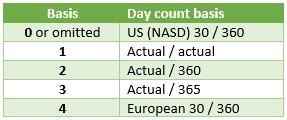A to Z of Excel Functions: The INTRATE Function
5 April 2021
Welcome back to our regular A to Z of Excel Functions blog. Today we look at the INTRATE function.
The INTRATE function
First introduced in Excel 2007, the INTRATE function will calculate the interest rate for a fully invested security. For example, it is particularly useful in calculating the interest rate of an unlisted bond.
The INTRATE function employs the following syntax to operate:
INTRATE(settlement, maturity, investment, redemption, [basis])
The INTRATE function has the following arguments:
- settlement: this represents the security's settlement date. The security settlement date is the date after the issue date when the security is traded to the buyer
- maturity: this is the security's maturity date, i.e. when the security expires
- investment: this is the amount invested in the security
- redemption: this is the amount to be received at maturity
- basis: the type of day count basis to use. This is the only optional argument. There are five options:

It should be further noted that:
- Microsoft Excel stores dates as sequential serial numbers so they can be used in calculations. By default, January 1, 1900 is serial number 1, and January 1, 2008 is serial number 39448 because it is 39,448 days after January 1, 1900
- dates should be entered using the DATE function, or as results of other formulae or functions. For example, use =DATE(2020,2,29) for the 29th of February, 2020. Problems may occur if dates are entered as text
- the settlement date is the date a buyer purchases a coupon, such as a bond. The maturity date is the date when a coupon expires. For example, suppose a 30-year bond is issued on January 1, 2008, and is purchased by a buyer six months later. The issue date would be January 1, 2008, the settlement date would be July 1, 2008, and the maturity date would be January 1, 2038, 30 years after the January 1, 2008, issue date
- settlement, maturity and [basis] are truncated to integers
- if settlement or maturity is not a valid date, INTRATE returns the #VALUE! error value
- if investment ≤ 0 or if redemption ≤ 0, INTRATE returns the #NUM! error value
- if basis < 0 or if basis > 4, INTRATE returns the #NUM! error value
- if settlement ≥ maturity, INTRATE returns the #NUM! error value
- INTRATE is calculated as follows:

where:
- B = number of days in a year, depending upon the basis
- DIM = number of days from settlement to maturity.
Please see my example below:

We’ll continue our A to Z of Excel Functions soon. Keep checking back – there’s a new blog post every other business day.

